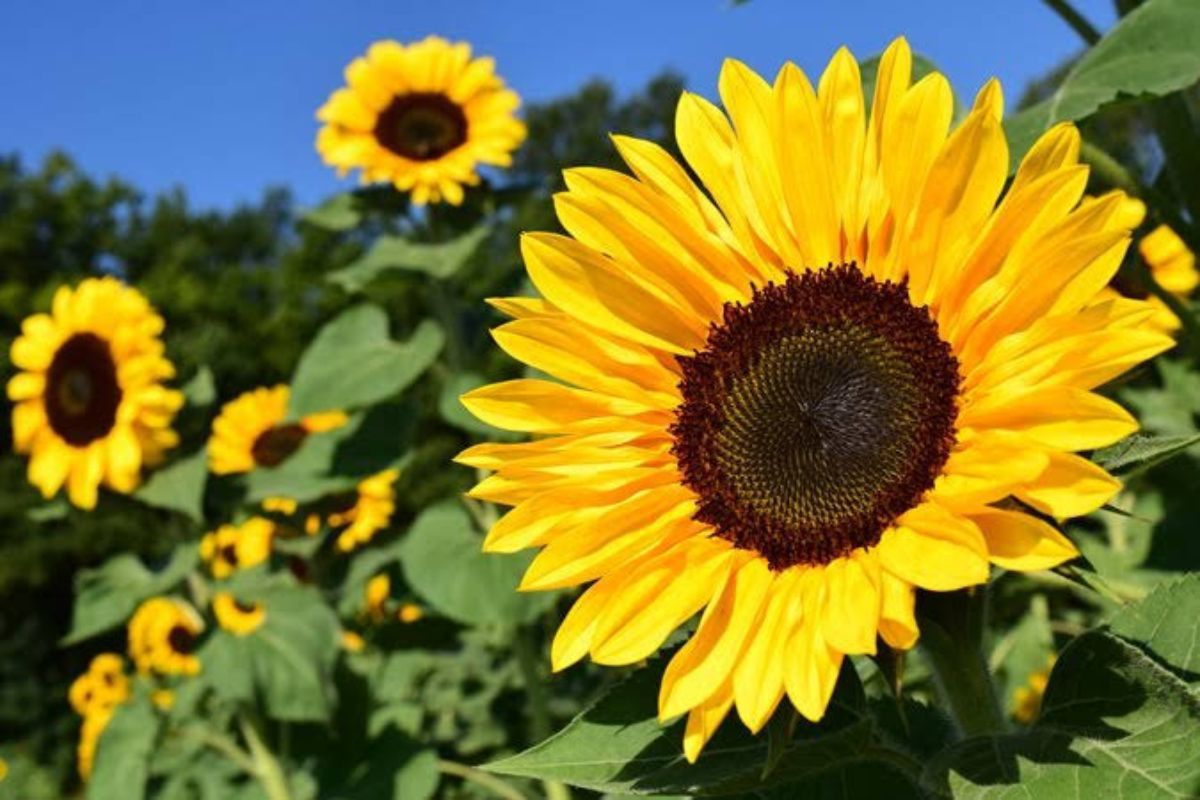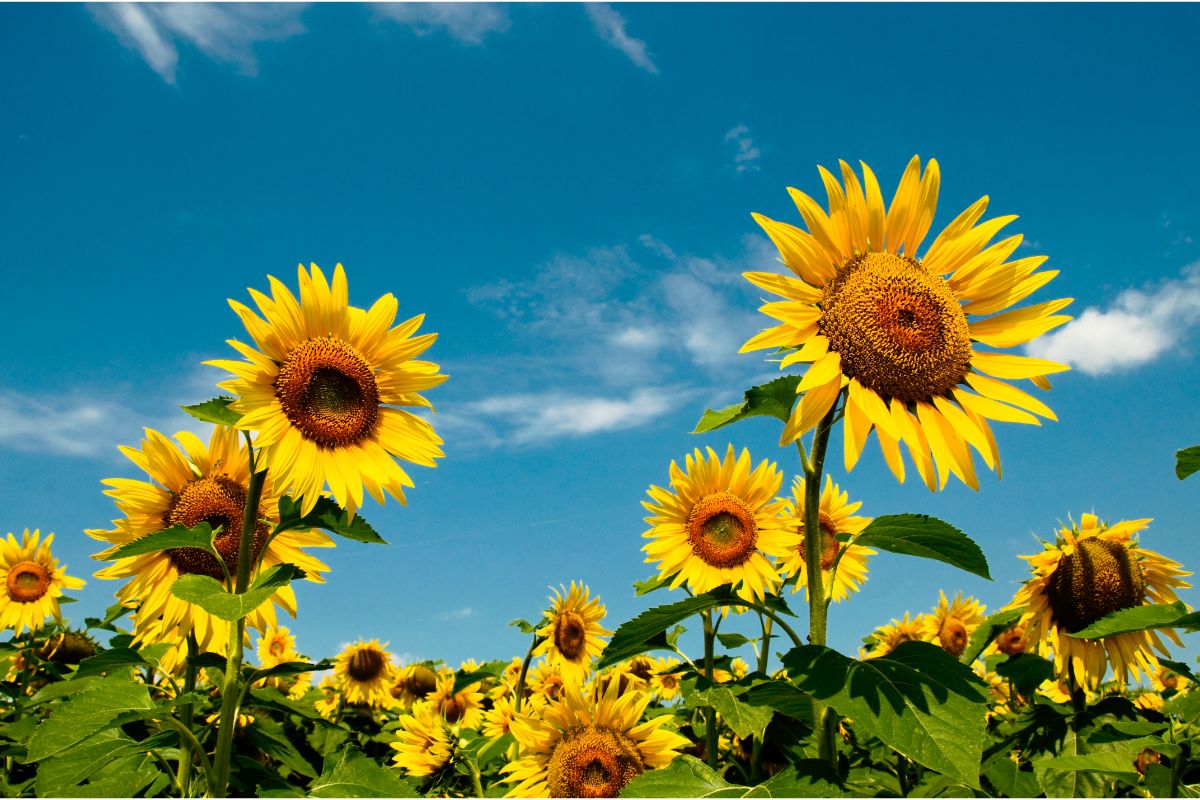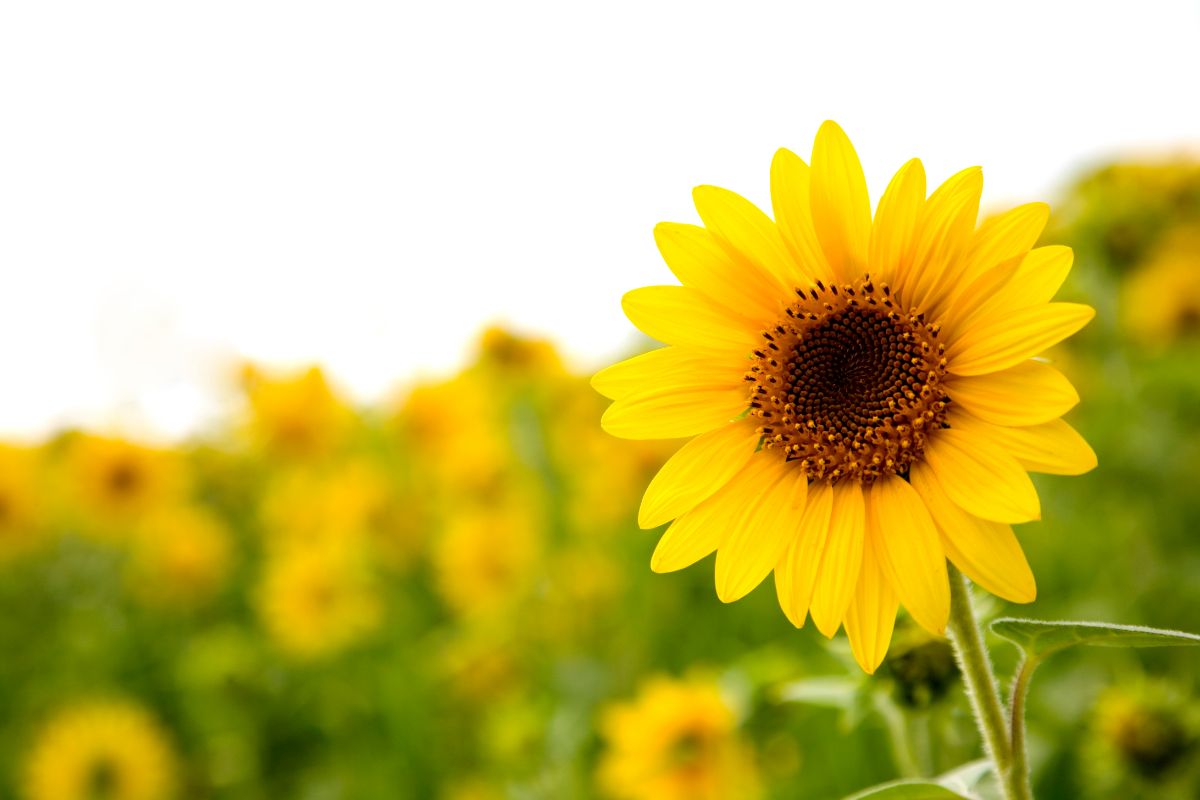Known for their large, bright yellow blooms, sunflowers are a popular garden plant enjoyed worldwide.
However, like any plant, sunflowers can fall victim to various pests and diseases that can cause problems for their leaves. Identifying and addressing these issues is essential for maintaining the health and vitality of your sunflower plants.

One of the most common problems affecting sunflower leaves is fungal infections. Fungi such as rust and powdery mildew can cause unsightly spots, discoloration, and deformities on sunflower leaves.
These infections can spread quickly and cause significant damage if left untreated. Additionally, sunflowers are prone to attack by a range of insects, including aphids, beetles, and caterpillars.
These pests can chew through the leaves and stems of your plants, causing wilting and leaf drop.
Another common problem that can affect sunflower leaves is nutrient deficiencies. Sunflowers require a range of nutrients to thrive, including nitrogen, phosphorus, and potassium.
If your soil is lacking in any of these nutrients, it can lead to stunted growth, yellowing leaves, and poor flower production.
Identifying and addressing these nutrient deficiencies is crucial for ensuring the long-term health of your sunflower plants.
In this guide, we’ll discuss some of the most common sunflower leaf problems and how to identify them. Therefore, you can tackle these problems before it’s too late and your sunflower suffers too much.
Sunflower Leaves Appearance
The majority of sunflower leaves have a triangular or heart shape with a small spine separating distinctive sections. They tend to have a dark green color but different types of sunflowers can have different colored foliage.
The leaves are typically arranged in an alternating pattern along the stem and are attached to the stem by a long petiole.
The leaves are usually bright green in color, but this can vary depending on growing conditions. Some sunflowers may have a slight bluish tint to their leaves, while others tend to have a darker green color.
As a sunflower grows, so do the leaves. These can become very large, depending on the type of sunflower, until they fill out around and below the sunflower head. They can also develop more pronounced serrations on the edges.
They may also become slightly more oval-shaped or elongated, depending on the specific variety of sunflower.
Sunflower leaves are also covered with tiny hairs that give them a rough texture and protect them from pests and other environmental stressors. These hairs also help to conserve water by reducing transpiration from the leaves.
Because sunflowers have two cotyledons (part of the embryo within the seed of a plant), they are considered dicots (has reticulate venation on the leaves). This also means that the leaves of a sunflower grow in sets of two.
Ultimately, healthy sunflower leaves should be bright green, firm, and free of any spots, discoloration, or signs of damage.
My Sunflower Leaves Are Being Eaten – What’s Eating Them?
Your sunflower plants may fall prey to various pests that can harm them. Take a close look at both the upper and lower surfaces of the leaves to spot any caterpillars, insect eggs, or other bugs that might be present.
In certain gardens, rabbits and groundhogs may take a liking to the tender shoots of young sunflowers, and slow growth can be a death sentence for these plants.
However, if the sunflowers are able to grow tall and fast enough, they may survive this initial assault.
Alternatively, if the pests only manage to nip the tops of the sunflowers, new shoots can emerge from the “armpits” of the leaves, allowing the plants to recover and continue to thrive.
Here are the main culprits that commonly like to nibble your precious sunflower leaves:
Caterpillars
Various types of caterpillars, such as the sunflower moth caterpillar, can cause significant damage to sunflower leaves by eating large holes in them.
Aphids
These small, soft-bodied insects can gather in large numbers on the undersides of sunflower leaves and suck the sap from them, causing the leaves to curl and distort.
Leafhoppers
These tiny, wedge-shaped insects can pierce the leaves of sunflowers and suck out the sap, causing a characteristic pattern of yellow or white stippling on the leaves.
Japanese Beetles
Adult beetles feed on sunflower leaves, creating holes and causing significant damage. Their larvae also feed on the roots of sunflowers.
Grasshoppers
These insects can devour entire sunflower leaves and cause significant damage to the plant’s overall growth and health.
Slugs And Snails
These pests can leave irregular holes in the leaves of sunflowers, and their feeding can result in significant damage, especially to young seedlings.
Rabbits And Groundhogs
These animals can nibble on the leaves and stems of sunflowers, causing significant damage to the plant’s growth and development.
How To Stop Your Sunflower Leaves From Being Eaten

There are a few ways to try and stop pesky bugs and animals from eating your sunflower leaves. Below are several preventive measures and control methods to try out:
Place Physical Barriers Around Your Plant
Place a barrier such as a mesh or netting around your sunflower plants to prevent animals like rabbits and groundhogs from reaching them.
Handpick The Bugs Off
If you notice any caterpillars, beetles, or other pests on your sunflower leaves, manually remove them and dispose of them.
Apply Insecticidal Soap
Apply insecticidal soap to the leaves of your sunflower plants to kill off any soft-bodied pests, such as aphids or leaf hoppers.
Use Companion Planting
Plant companion plants like marigolds or lavender around your sunflower plants to repel pests and attract beneficial insects like ladybugs or lacewings.
Maintain A Clean And Tidy Yard
Remove any fallen leaves, debris, or other organic matter from around your sunflower plants, as these can attract pests and provide shelter for them.
Use Organic Pesticides
Apply organic pesticides like neem oil, which can help control various types of pests without harming beneficial insects.
By following these methods, you will give your sunflower leaves the best chance of staying healthy and help prevent them from being eaten by pests.
Understanding What Is Wrong With Your Sunflower
You know that saying “the eyes are the windows to your soul?” Well, for plants, the leaves are the windows to their health. By this, we mean you can tell a lot about a plant’s health by inspecting its leaves.
You can figure out whether the plant is thirsty or if it has come under attack from certain pests just by looking at the leaves.
Let’s take a look at some common leaf signs that your sunflower could do with some tender loving care:
The Leaves Are Droopy
If you notice droopy sunflower leaves, it may be a sign that your plant requires additional watering.
When a sunflower is thirsty, it usually displays this by wilting its leaves. However, it is important to note that wilting can also signify that the plant is receiving an excess of water.
To achieve optimal results, it is recommended to monitor your watering practices and rainfall levels. You can do this by keeping a gardening journal.
The Leaves Are Curling
When sunflower leaves begin to curl and show signs of discoloration, it could be indicative of a disease such as Verticillium. This disease can cause the leaves to display a combination of mottled green, yellow, and crispy brown discoloration.
The Leaves Start To Turn Yellow
If your sunflower leaves start to turn yellow, it’s a symptom of being overwatered or the plant has poor drainage. Too much water can come from excess rainfall, too.
Yellow leaves can also be a sign of a nitrogen deficiency. You can provide the sunflower with more nitrogen by using Bloodmeal and manure fertilizers.
Some Leaves Are Missing
If you find that larger animals like groundhogs, woodchucks, rabbits, or deer are invading your garden and eating your plants, there are a few things you can do.
If your sunflower has been nibbled above the cotyledon, it’s best to leave it in the ground. With a bit of patience, you’ll likely see two new shoots sprouting from each side. Although the sunflowers may end up smaller than expected, at least you won’t lose the entire plant.
There Are Holes In The Leaves
Take a look at the top and underside of your sunflower leaves to see if there are any egg clusters or eggs present. Various pests, such as caterpillars, can devastate sunflower seeds that you may want to harvest later on. So tackle these before they cause carnage.
The Leaves Become Crispy And Brown
A sunflower exhibiting entirely crisp and brown leaves is likely experiencing severe dehydration or nearing the conclusion of its growing cycle. When the sunflower seed head remains on the plant to allow the seeds to ripen, the leaves’ eventual state is anticipated.
Can You Eat Sunflower Leaves?

We now know that certain animals and little critters love to nibble on sunflower leaves, but the question remains – are sunflower leaves safe for human consumption?
Overall, sunflower leaves are considered edible and work as greens in different salads. You can use them as you would many other transitional greens, such as lettuce. However, you should inspect the leave’s condition before eating, as well as its texture.
Sometimes, sunflower leaves may not add anything to a dish, or their rougher texture could spoil a meal.
You’ll be hard pressed trying to find sunflower leaf recipes online and that is why many people prefer to stick to using sunflower seeds rather than the leaves in recipes.
Although not commonly eaten, the young leaves of sunflowers can be used in salads, and the older leaves can be cooked like other leafy greens such as spinach or kale.
However, as we mentioned, sunflower leaves have a slightly bitter taste and a tough texture, so they are not as commonly used in cooking as other greens.
If you do decide to use sunflower leaves in your cooking, they can be paired with ingredients such as garlic, lemon, olive oil, or vinegar to help balance out their flavor.
It’s important to note that if you plan to eat sunflower leaves, you should only consume those from plants that have not been treated with pesticides or other harmful chemicals.
Sunflower Leaf Diseases
Sunflowers are hardy plants, so stand up well to harsh weather conditions and diseases. Nevertheless, there are some certain leaf spot diseases that can affect sunflowers. These can cause yellow patches or surface spots that impede the plant’s appearance.
Downy Mildew
This fungal disease appears as yellow or brownish patches on the upper side of leaves, with a corresponding grayish-purple fuzzy growth on the undersides. It can cause severe defoliation in susceptible cultivars.
Rust
Rust is caused by a fungal pathogen that appears as small, reddish-brown pustules on the underside of leaves. The upper surface of the leaves may appear yellow and spotted. In severe cases, rust can cause significant defoliation and yield loss.
Verticillium Wilt
This fungal disease can cause yellowing and wilting of sunflower leaves, with brown streaks appearing on the stems. It can also cause reduced growth and yield.
Powdery Mildew
Powdery mildew appears as a white or grayish powder on the upper surfaces of leaves, stems, and flower heads. It can cause stunted growth and reduced yield.
Phoma Black Stem
This fungal disease causes the stem to turn black, and it can cause sunflower leaves to turn yellow and wilt. It can also cause reduced yield.
Here are several diseases that can affect sunflower leaves:
The most common threat to sunflower plants is Sclerotinia stem rot, also known as white mold. This is a type of fungus that can cause the leaves to wilt suddenly. It can also cause the flower head and root to rot, and stem canker.
You can reduce the chances of this disease by performing crop rotation and by watering the plant regularly.
Yellow Leaves – What Does This Mean?
Yellow sunflower leaves tend to mean that the sunflower has been overwatered. It can also indicate waterlogged soil, leaf spot disease, or a nitrogen deficiency.
Here’s how to try and cure yellow sunflower leaf issues:
Check For Pests
Look closely at the yellow leaves for any signs of pests such as aphids, whiteflies, or spider mites. If you find any, treat the plants with insecticidal soap or neem oil according to the instructions on the product.
Assess The Soil
Make sure the soil is well-drained and that the sunflowers are getting enough water. Water the plants deeply and regularly, but avoid overwatering which can lead to root rot.
Check For Nutrient Deficiencies
Yellow leaves can also be a sign of nutrient deficiencies such as nitrogen, iron, or magnesium. Consider adding fertilizer or compost to the soil to provide the necessary nutrients.
Prune Damaged Leaves
If the yellow leaves are damaged or diseased, prune them off to prevent the issue from spreading to other parts of the plant.
Provide Proper Sunlight
Sunflowers need plenty of sunlight to grow and thrive. Make sure they are planted in a location that receives at least six hours of direct sunlight each day.
Brown Leaves – What Does This Mean?

It is quite normal for a sunflower’s leaves to turn brown towards the end of the growing season. It is at this point when you can start harvesting the flower’s seeds and then place the remainder of the plant in the compost.
If your sunflower leaves turn brown before this time, though, it could be a sign of several things, including lack of water, overwatering, pests, disease, or environmental stress.
Here are some steps you can take:
Check The Watering
Ensure that the sunflowers are getting enough water. If the soil is dry, water the plants deeply. On the other hand, if the soil is waterlogged, stop watering and let it dry out for a few days.
Check For Pests And Diseases
Examine the leaves and stems for any signs of pests, such as aphids, spider mites, or caterpillars. If you find any, use an appropriate insecticide or pesticide to control the infestation. Also, look for signs of disease, such as spots or lesions on the leaves, and treat them with fungicides.
Prune The Affected Leaves
If the brown leaves are concentrated in one area, prune them off with sterile pruners. This will help to prevent the spread of any disease or pests and encourage new growth.
Improve The Soil
Sunflowers prefer well-drained soil with plenty of organic matter. If the soil is too compacted, add compost or organic matter to improve soil structure and drainage.
Monitor The Environment
Make sure that the sunflowers are not exposed to excessive heat or cold, which can cause stress and damage the leaves. Also, ensure that they are getting enough sunlight and that they are not in a location that is too windy.
By following these steps, you can help your sunflowers recover and prevent the leaves from turning brown and prevent the issue from recurring in the future.
White Leaves – What Does This Mean?
If your sunflower leaves have turned white, it may indicate a fungal disease, such as powdery mildew. Sunflowers grown in damp or humid conditions are particularly susceptible to such issues.
You can treat powdery mildew on your sunflower leaves by using a fungicide spray, or you can make your own formula. Mix two to three tablespoons of apple cider vinegar with four liters (one gallon) of water. Place into a spray bottle and spray the leaves.
Here are some further steps to take to ensure the health of your sunflower leaves if they have turned white:
Inspect The Leaves
Examine the white leaves closely to determine the cause of the problem. Look for any visible signs of pests, like those previously mentioned, or signs of diseases like powdery mildew or rust.
Address Any Pest Issues
If you notice any pests, you may want to treat the sunflowers with an insecticidal soap or neem oil. These products are typically effective against common garden pests and can be purchased at a garden center.
Address Any Disease Issues
If you suspect a disease, you may want to remove the affected leaves and dispose of them in the trash. If the disease has spread throughout the plant, you may need to treat it with a fungicide or bactericide.
Check For Nutrient Deficiencies
White leaves can also be a sign of nutrient deficiencies. Sunflowers require adequate amounts of nitrogen, phosphorus, and potassium. If your soil is lacking in these nutrients, you may want to fertilize your sunflowers with a balanced fertilizer.
Ensure Proper Watering
Sunflowers require consistent moisture to grow healthy leaves. Make sure that the soil around your sunflowers is evenly moist, but not waterlogged.
With proper care and maintenance, your sunflower can remain healthy. But, sometimes, things are out of your control. The best methods are typically preventative techniques so your sunflower never suffers from anything.
How To Know When A Sunflower Is Dying
There are various reasons why a sunflower can start to die. Many problems can arise when sunflowers are left to the elements and nature but if you identify them early enough, you can usually return the plant to its former floral glory.
On the other hand, if you fail to act in time, it may be too late and your plant can start to die.
As mentioned, the first signs of a dying plant tend to be yellow leaves, indicating either overwatering, a nitrogen deficiency, or it could simply be that the plant is aging.
Another sign can be stunted growth. If new tips that have developed look a little abnormal and seem to have stopped growing all of a sudden, the plant may be dying. This will soon lead to the shedding of leaves.
Before they shed, though, the leaves may turn yellow, or brown, and start to develop black spots on their surface.
Also, if the plant has been overwatered, either by you or from excessive rainfall, then the leaves will begin to wilt. The same happens if the sunflower has been under watered.
In most cases, you can take preventative measures and bring the sunflower back to a healthy state. But, if there are signs of mold or root rot, it is probably too late and the plant will die whatever you try.
What To Do With A Dead Sunflower
There are several things you can do with a dead sunflower, depending on your preference and the state of the plant. Here are some options:
Harvest The Seeds
If the sunflower head is dry and the seeds are brown and plump, you can harvest the seeds by cutting off the head and letting it dry further in a warm, dry place for a few weeks (find our guide on drying sunflower heads here).
Once the seeds are completely dry, you can remove them from the head and store them in an airtight container for future use or to plant next year.
Compost It
If the sunflower head is too damaged or not suitable for seed harvesting, you can add it to your compost pile. Sunflowers are rich in nutrients and will add valuable organic matter to your compost.
Use It For Decorative Purposes
If the sunflower head is still intact and has some visual appeal, you can use it for decoration. You can spray paint it, attach it to a wreath or garland, or use it in a fall-themed centerpiece.
Leave It For The Wildlife
Dead sunflowers can provide a food source and shelter for birds and other wildlife. You can leave the sunflower in your garden or yard and watch as wildlife makes use of it.
In Summary
By inspecting the leaves of sunflowers, you can tell a lot about the plant’s overall health. Save this article so you can revisit it when checking up on your sunflowers next.
- Interesting Flowers That Start With A - July 21, 2023
- Interesting Flowers Beginning With H - July 21, 2023
- 14 Fascinating Flowers That Begin With C - July 20, 2023
